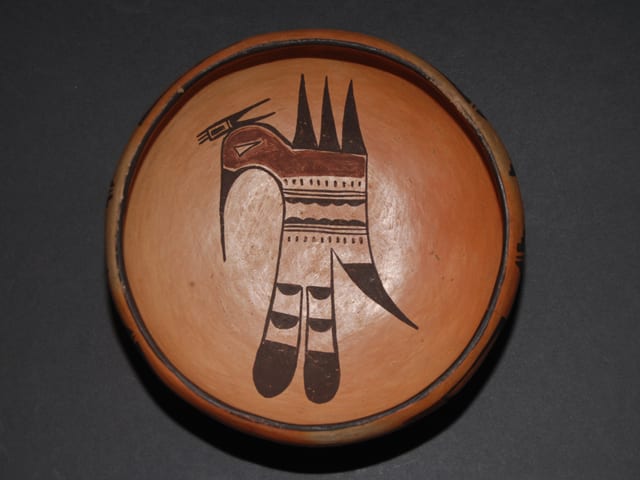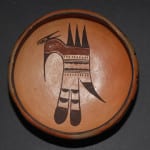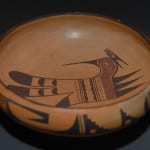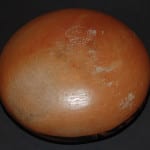This Hopi-Tewa shallow bowl has an incurving rim, a single folk art bird interior design, and a four-element exterior design, repeated twice. The bowl is not particularly well made; it is slightly asymmetrical and has an uneven rim. Nevertheless, this is a compelling pot—given the whimsical power of the bird hovering in flight and the somewhat complex exterior design that (given the incurved rim) visually frames the interior design when the bowl is viewed at a slight angle. Overall, the casual folk elegance of the bowl stands in sharp contrast to the technically proficient, perfectly designed pottery that is characteristic of much of the “fine art” pottery produced today at Hopi.
Characteristic of Hopi-Tewa design, the interior avian image is both internally complex and yet fits together into a single, simple element that takes energy from its internal complexity. The two lower tail elements visually link with the three-pointed triangular forms on top to establish a clear vertical axis for the bird. The central body core consists of parallel rows of ten dots, two lines, and scalloped elements framing an unpainted area. These designs work together to give the folk bird a horizontal axis, though the scalloped black edges and the resulting framed negative space gently complicate this horizontal thrust. Together, these vertical and horizontal patterns draw the eye to the center of the avian image, and hence towards the center of the bowl.
Two curved elements contradict the linearity of these vertical and horizontal patterns: 1) the upward sweep of the tail image, which 2) is itself counterbalanced by the downward sweep of the head and beak. The left beak is almost parallel to the right edge of the avian image, thus using two curved elements to defined almost linear boundaries, a contradiction. Moreover, the dramatic downward thrust of the head and beak is itself contradicted by the gently downward tilt of the head crest.
Other details further show the Hopi-Tewa penchant for counterbalance design. Notice the bullet-shaped negative space formed by the right points of the head crest. The negative space moves to the left while the framing lines point right. Moreover, rightward energy of the triangular eye contradicts the leftward motion of the negative space immediately above it.
The small red element of the body contains both rectangular and curved areas, which further unifies the contradictory elements of style. The red paint is somewhat blotchy, which suggests a pre-1930 date of production.
There is no suggestion that Nampeyo made this pot; however, like “the Old Lady,” the unknown maker of this bowl has used negative space to emphasize the central avian design. Given energy by its internal contradictions, this folksy bird seems to hover in air like a hummingbird. The exterior design is by definition horizontal since it is painted around the rim of the bowl, but the design also incorporates contradiction. The two central elements of the design are visually vertical, while the leading and ending elements have horizontal energy. As with the head crest, these first and last elements use negative space to define forms with contradictory visual energy. The leading element has a negative space that points to the rear; the last element has negative space that points forward—thus unifying the overall design. The vertical thrust of the two central elements of the exterior design is interrupted by circular negative space. This is simple folk-art bowl was constructed by a master artist.





